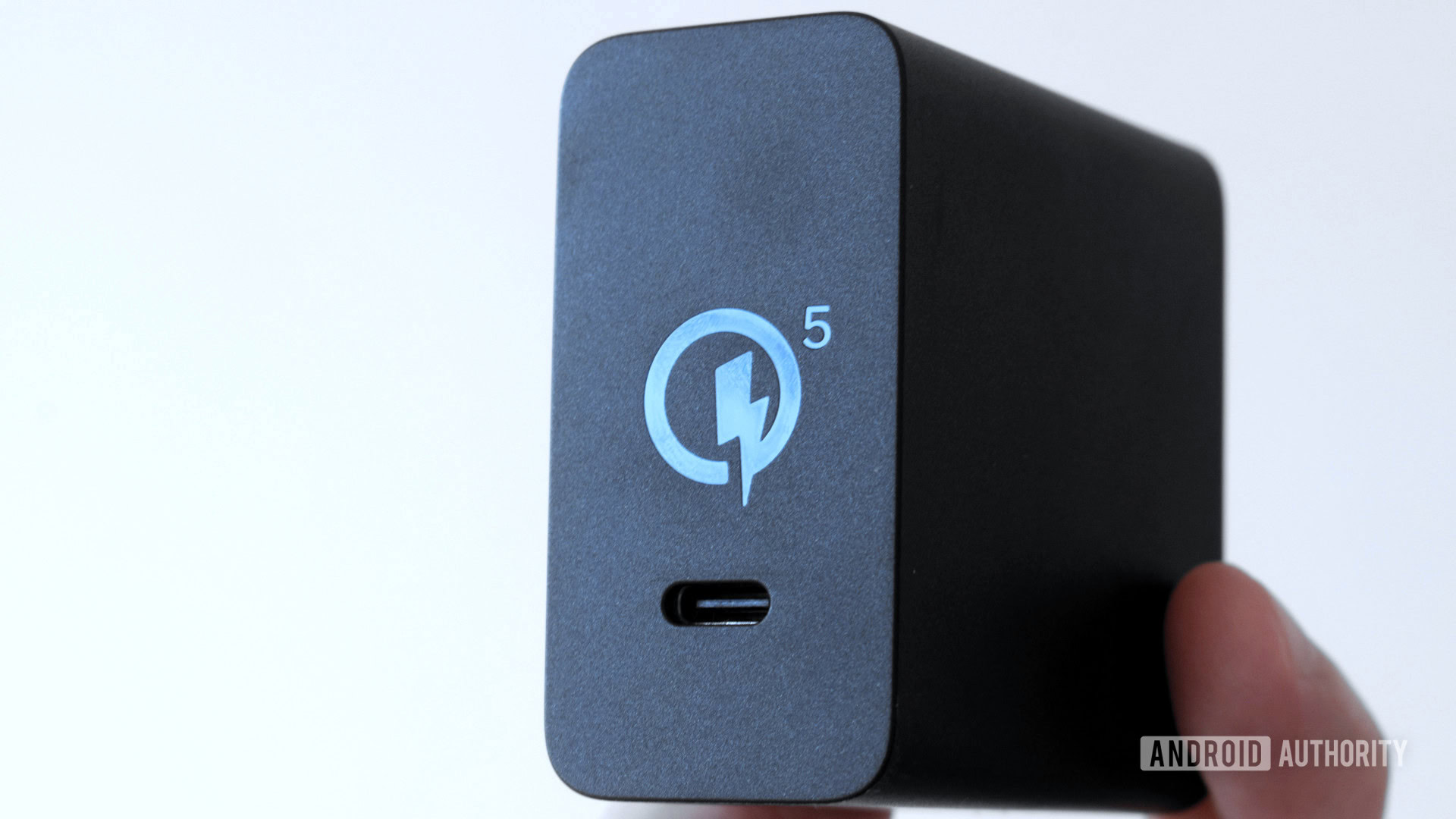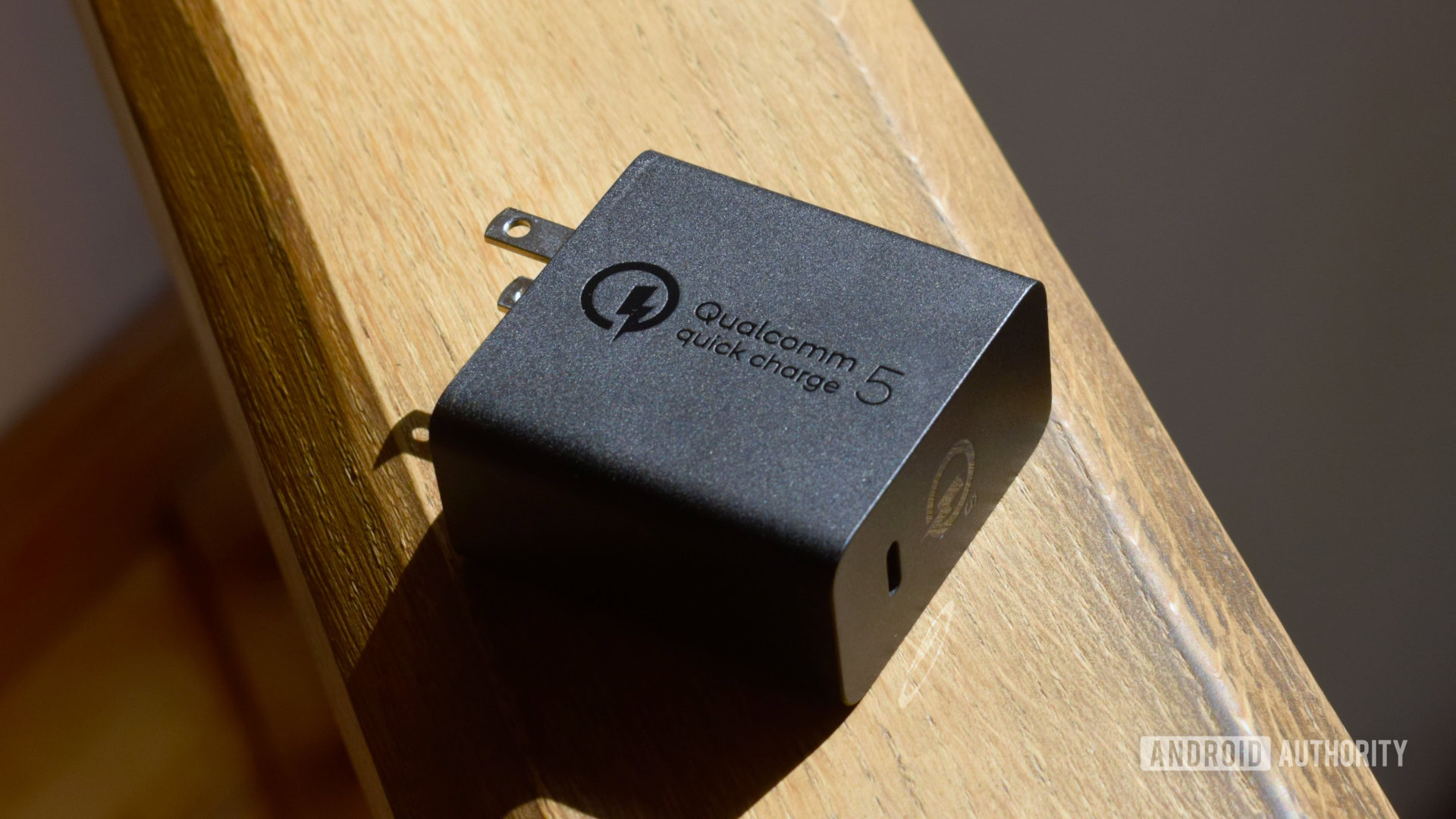Affiliate links on Android Authority may earn us a commission. Learn more.
Quick Charge 5 tested: Smarter charging for longer battery life
Published onAugust 16, 2021

Fast charging is a complicated beast that’s pushing the boundaries with ever more power. Qualcomm’s Quick Charge 5 bundles over 100W of power, battery, and other sensor-aware algorithms, and a healthy dose of backward compatibility together for its most powerful and intelligent fast charging standard yet. Importantly, Quick Charge 5 is compatible with the more universally adopted USB Power Delivery and its PPS variant — meaning it’s a standard that should have all of your modern gadgets covered.
We’ve seen plenty of blazing-fast charging technologies grace the market in 2021, although most of them run quite hot, which is bad for battery longevity. So can Quick Charge 5 do any better? We’ve tested the 65W charger that comes bundled with Qualcomm’s Smartphone for Snapdragon Insiders (SFSI) to see how it stacks up against rival standards.
Update 18 Aug 2021: Qualcomm has been in touch to stress that the performance we’ve measured applies to just one implementation of Quick Charge 5 rather than the standard as a whole. This was noted in the original article but we’ve updated the text to make this clearer.
Quick Charge 5: Charging speeds compared
To get a feel for how this implementation of Quick Charge 5 compares to other standards, I started by testing Qualcomm’s Smartphone for Snapdragon Insiders using a variety of common standards. Here’s the rundown:
- Quick Charge 5: 42 minutes to full, 45W max, 38.7°C peak
- Quick Charge 3: 67 minutes to full, 18W max, 34.5°C peak
- USB Power Delivery PPS: 51 minutes to full, 35W max, 34.2°C peak
- USB Power Delivery: 65 minutes to full, 18W max, 32.5°C peak
As you’d expect, Quick Charge 5 is significantly faster than Qualcomm’s older but very popular Quick Charge 3 standard. It provides much more power to the handset than the old standard — about 45 watts versus 18 watts. Importantly though, the new standard isn’t too much hotter than the old one, but more on that in a minute. USB PD PPS isn’t far behind Quick Charge 5, and both are faster than the more basic USB Power Delivery standard, as the former is able to communicate a requirement for more current than the 3A limit of the latter.
What’s also interesting is that Quick Charge 5 uses USB PD PPS as its underlying communication protocol, yet the phone negotiates a higher 17V for 45W of power in Quick Charge 5 mode. USB PD PPS sits at a lower 9V but higher 4A of current for 35W of power. Despite this power difference, USB PD PPS isn’t too much slower than Quick Charge 5 — there are only nine minutes in it, sometimes even less than that. There’s definitely extra proprietary negotiation running on top of the protocol here and this has implications for more than just basic power negotiation.
Usage and temperature aware charging

What’s most interesting about Quick Charge 5 is that the Smartphone for Snapdragon Insiders’ implementation is usage and temperature-aware. This is clearly Qualcomm’s take on how the standard should be implemented, although not all of its partners implement the same features in their Quick Charge 5 phones.
When charging using Quick Charge 5, the charger provides up to 45W (16.7V, 2.67A) of power to the SFSI so long as the screen is off and the temperature remains below about 38°C. Once this limit is exceeded or the phone is used while charging, the charger reduces the power down as far as 18W (15.8V, 1.16A) until the temperature falls to a lower level. Interestingly, peak power switches to 15W and a lower voltage (8.7V, 1.77A) once the battery hits 85% and then drops down to 5W near full. This is why it takes so long to finish charging after hitting 99%.
Related: The best phone charging accessories
Temperature and usage-aware charging are obviously very beneficial for battery longevity, as it keeps the cell below the red hot 40°C limit and closer to the slightly less uncomfortable 35°C margin. We’ve been concerned about other very fast charging technologies that push battery temperatures well beyond these limits, but rival technologies do charge faster as a result. After an initial quick burst, the charging power yo-yos but ends up spending most of its time at 30W or below. This averaging of charging power is why Quick Charge 5 is not too much faster than USB PD PPS, in this example, despite offering a higher maximum power.
A downside of this technique is that it causes charging power and speed to vary a bit. I clocked the phone reaching full charge between 42 and 53 minutes, the latter being closer to Qualcomm’s official figure. I find the system a little oversensitive, as simply waking your phone to check a notification is enough to drop the charging power down dramatically, and it takes some time to recover. I plotted three QC5 charging cycles on the graph below to showcase how this affects charge time and the battery temperature, and you can clearly see the non-smooth charging time as the power adjusts up and down.
Similar behavior is observed with Quick Charge 3.0 and USB Power Delivery, although not to the same extent. The two drop their power from 18W to 12W when turning the screen on. But the standard is slower and cooler to begin with, so this doesn’t seem anywhere near as necessary.
This same behavior is not observed when charging via USB Power Delivery PSS. Power peaks at a lower 35W (8.7V, 4.0A) and falls as the phone charges, resulting in much less heat to begin with. Charging temperatures only reached 34.2°C. What’s interesting here is that USB PD PPS provides nearly twice the power of Quick Charge 3 yet maxes out at roughly the same temperature.
Quick Charge 5 vs other charging standards
Here at Android Authority, we’ve tested a few ultra-fast charging standards and have been a little concerned that so many of them push battery temperatures well above 40°C for long periods of time. This includes OnePlus’ 65W Warp Charge, Xiaomi’s 120W technology (which is also based on Quick Charge 5), and, to a lesser extent Infinix’s 160W Concept Phone. Generally speaking, the faster you want to charge your phone, the more power is required, resulting in more heat.
As you can see from the results above, Qualcomm’s 65W Quick Charge 5 powering the Smartphone for Snapdragon Insiders is notably cooler than other fast-charge technologies but it does take a little longer to fill a battery, taking at least 50% as long as 65W Warp Charge. Although this obviously doesn’t take into account the different battery capacities, so the temperature measurements are more interesting. Quick Charge 5 is 5°C cooler in terms of max and average temps compared to the hottest competition. In addition to the temperature-aware charging power, Quick Charge 5 uses new, efficient power management ICs which can be used in dual-mode to help dissipate heat, though it’s not clear if the Smartphone for Snapdragon Insiders is using this configuration or not.
65W Warp Charge is faster and hotter than 65W Quick Charge 5.
I’ve also run the math of average charging speeds per minute for these devices, to give an indication of how fast these technologies would perform for similar battery capacities.
- Quick Charge 5 65W (SFSI): 95mAh/min, 38.7°C peak, 34.7°C average
- USB PD PPS 35W: 78mAh/min, 34.2°C peak, 31.7°C average
- OnePlus 65W: 155mAh/min, 43.2°C peak, 39.7°C average
- Xiaomi 120W (QC5): 214mAh/min, 43.8°C peak, 39.2°C average
- Infinix 160W: 363mAh/min, 41.9°C peak, 37.9°C average
A caveat with this quick math is that battery makeup contributes to current handling and peak temperature, as well as discharge characteristics. For example, the expensive 8C battery in the Infinix Concept Phone helps it produce a fast charging speed with slightly lower temperatures than its rivals.
Interestingly, Xiaomi’s 120W charging tech in the Mi 10 Ultra is also based on Quick Charge 5. Clearly, this implementation is much faster than the SFSI but also runs much hotter and doesn’t seem concerned with temperature at all. This demonstrates how scalable Quick Charge 5 is but also means that the same features aren’t guaranteed across handsets. When it comes down to just a few minutes difference in charging times, it’s better to err on the side of a cooler battery.
Quick Charge 5: The verdict

Qualcomm’s Quick Charge 5 is the fastest Quick Charge implementation to date and can match the fastest standards around. But at the same time, it can be a more conservative standard than other ultra-fast charging technologies making their way to the market and that’s not necessarily a bad thing. It augments the USB Power Delivery PPS standard with the potential for faster charging speeds, as seen by the Smartphone for Snapdragon Insiders and Xiaomi 120W implementations I’ve tested. More importantly, temperature and usage-aware capabilities can ensure that the battery stays below 40°C while fast charging, an important marker that other standards are too eager to ignore in pursuit of faster charge times.
Based on the SFSI, this balanced approach is how Qualcomm thinks Quick Charge 5 should be used. And it’s certainly a good model for others to follow. However, this is not necessarily indicative of the performance or features you’ll find on every Quick Charge 5 phone.
Quick Charge 5 can be speedy yet cool — exactly what you want when fast charging.
Today’s testing really sums up the current crossroads in the fast charging market. On one side, brands are pursuing ever faster charge times with exceedingly high-power solutions. But to do this safely requires expensive battery and circuit components, more powerful chargers, and all too often proprietary standards. Even the best standards push beyond the boundaries of ideal battery temperatures. On the other side are the slower but more universal standards like USB Power Delivery. Their universal nature makes them slower to embrace the latest and greatest solutions to charge quickly, but they are very safe and run cooler than the competition.
Quick Charge 5 sits somewhere in between, retaining compatibility with popular standards while adding in extra features for its partners to leverage in the pursuit of lower temperatures and/or faster speeds. So is Quick Charge 5 any good? Absolutely. In fact, it’s one of the better fast charging standards available in handsets right now. Although remember, the exact implementation can vary quick a lot depending on the smartphone in question.